Cannes screening sparks new interest into Ray’s 1970 urban youth drama Aranyer Din Ratri
Fresh perspectives, deeper meanings and observations on Satyajit Ray’ s film Aranyer Din Ratri (Days and nights in the forest) comes with the screening of its restored 4K version in the 78th Festival de Cannes 2025.
It was yesterday once more when veteran Sharmila Tagore was joined by her co-actress Simi Garewal at the screening of Aranyer Din Ratri at the 78th edition of Cannes Film Festival in the French city on May 19.
Credit goes to, Purnima Dutta (producer who preserved the original negatives), Martin Scorcese's ‘The Film Foundation, filmmaker Wes Anderson (who led the restoration journey), India's trailblazing Film Heritage Foundation (led by Shivendra Dungarpur), Janus Films, and The Criterion Collection and an endless list of many others, known, unknown, famous, unfamous in front and behind its restoration and screening.
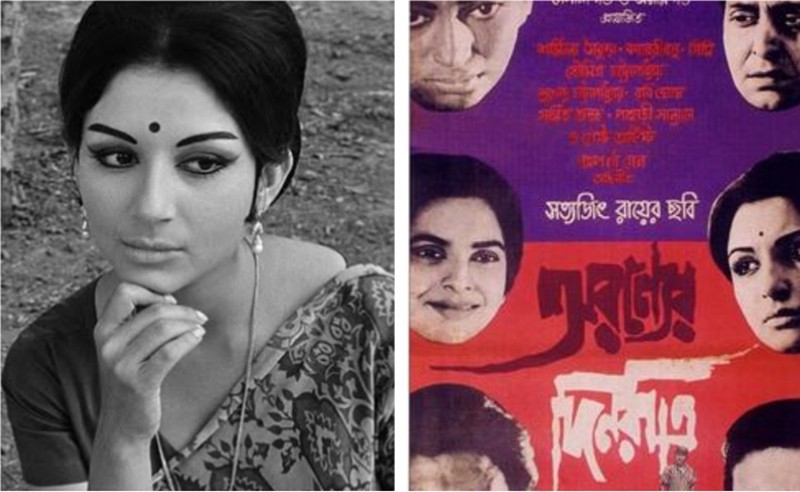 The 1970 poster of Aranyer Din Ratri where Sharmila, then a top commercial Bollywood actress, plays the female lead
The 1970 poster of Aranyer Din Ratri where Sharmila, then a top commercial Bollywood actress, plays the female lead
According to Variety, this is a collaborative effort between The Film Foundation’s World Cinema Project, Film Heritage Foundation, Janus Films and The Criterion Collection, with funding provided by the Golden Globe Foundation.
Funding was provided by the Golden Globe Foundation and never to forget Wes Anderson and Ray’s son Sandip Ray.
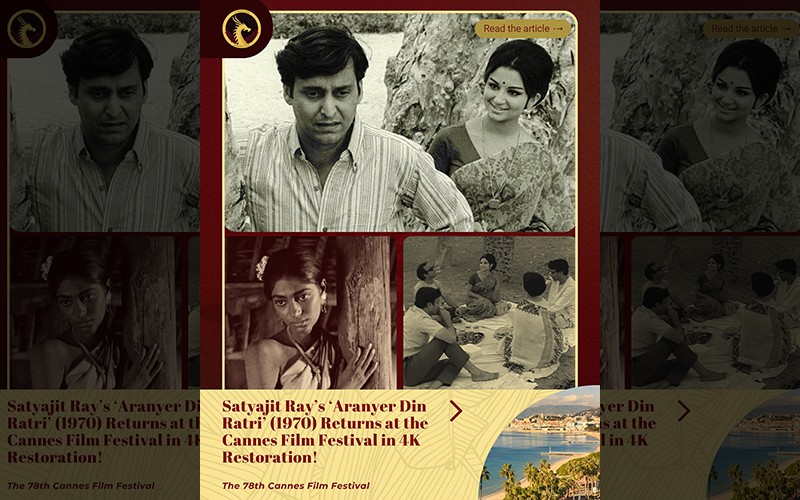 The Film Heritage Foundation restored the film
The Film Heritage Foundation restored the film
Ray in almost all his films made changes in the content of the root source from where they were adapted or altered it to sufficient extent, be it a novel or a short story to suit his needs and make it worthy of a motion picture. It did bring a new perspective not in ‘book paper’ but something absolutely new, in a new format, the Celluloid.
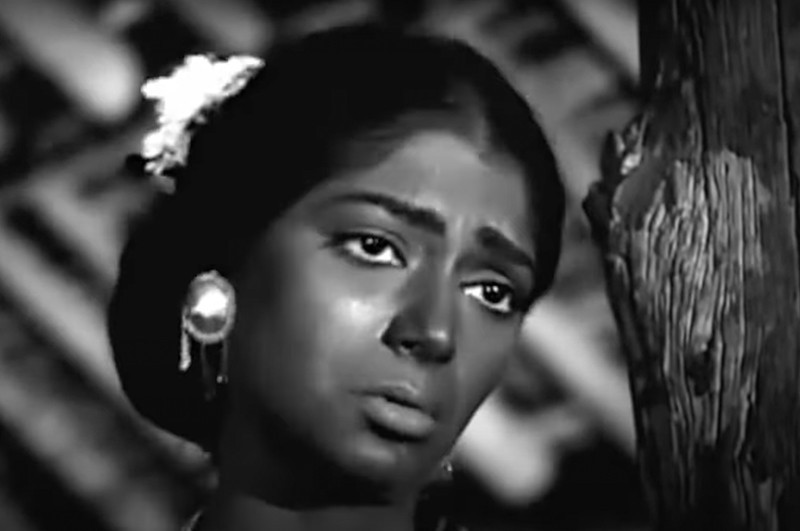 Simi plays a tribal woman
Simi plays a tribal woman
In his film Kapurush (The Coward, 1965, starring Soumitra Chatterjee and Madhavi Mukherjee) he changed the thought process in Premendra Mitra’s novel from which it was adapted, whereas in Aranyer Din Ratri he opened a new way to watch a group of four young lead characters, of whom no one is a protagonist in spite of his best effort. In ‘The Coward’ it was the hero who was suffering from indecisiveness more like a Hamletian Dilemma, whereas in Aranyer Din Ratri it is the age-old ‘Human Confusion’ one suffers from.
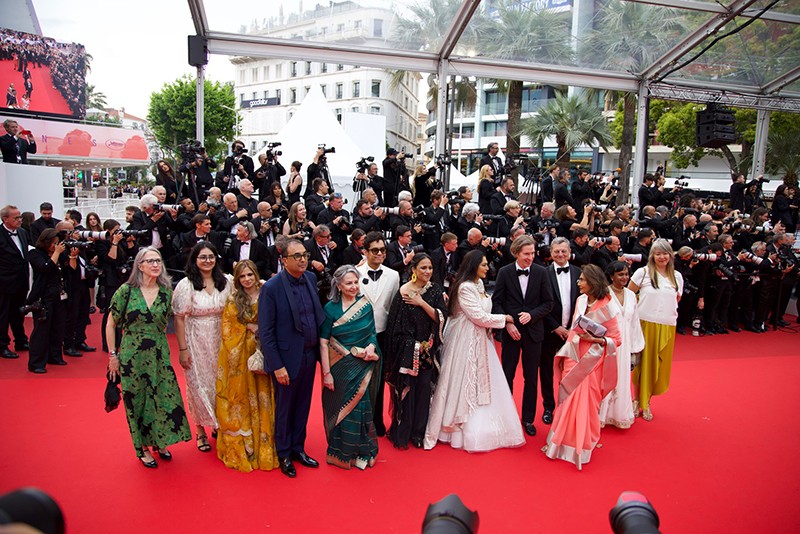 Sharmila and Simi at Cannes
Sharmila and Simi at Cannes
In indecisiveness there is difficulty in choosing, struggling to make a decision, even when the options are clear whereas in confusion it is a lack of clarity, poorer understanding rising from disorganized thoughts or it may be a simple state of bewilderment.
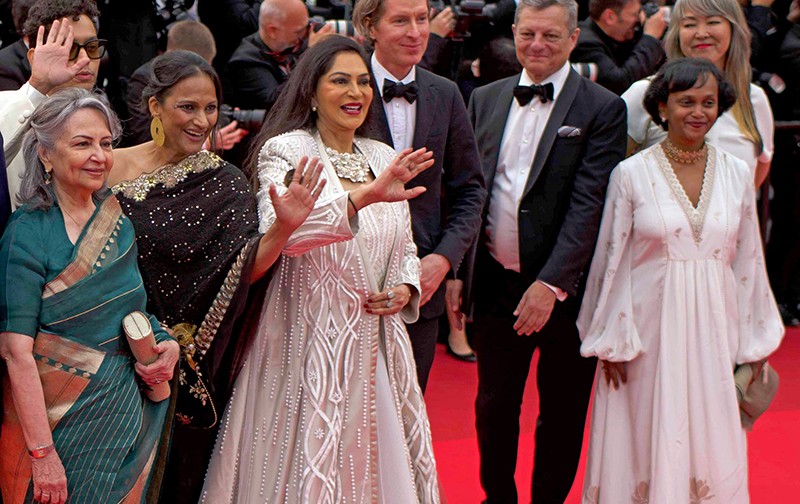 Sharmila Tagore and Simi at the red carpet at Cannes
Sharmila Tagore and Simi at the red carpet at Cannes
In this film Ray had discreetly and aptly arranged four characters of nearly same age, namely Asim (a corporate, moneyed, smart, upscale man more inclined to climbing the company’s ladder), Sanjay (a labor welfare officer, aware of old and present day politics and intellectually inclined), Sekhar (a sybarite and not a hedonist as has been referred to in older reviews) and Hari (a sportsman without any intellectual bent) like four cards placed one after the other without overlapping.
None of the characters here suffer from anxiety, depression, or other mental health conditions. They are merely normal individuals turned briefly wayward in a jungle surrounding away from their urban life.
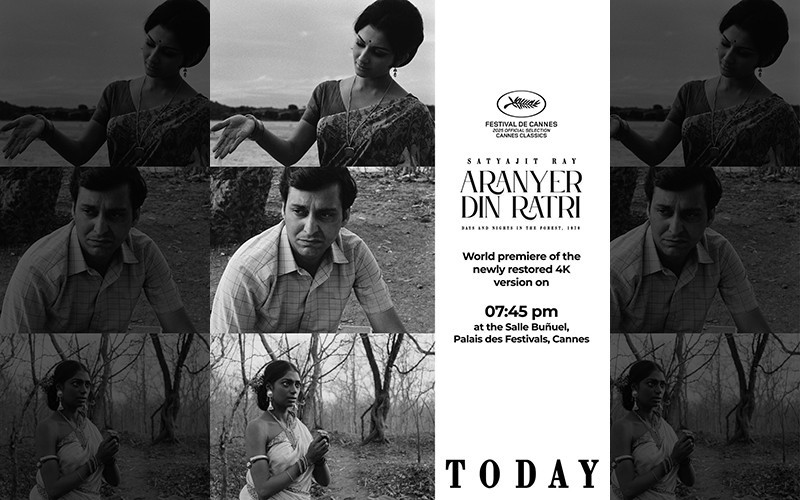 The Cannes screening flyer
The Cannes screening flyer
The film begins with an unforgettable acceleration of film cadence when the perforated title cards are shown and Ray’s music finds itself in the backdrop of the Santhal jungle about to be visited. The tempo of Ray’s chords rises from andante to utter allegro, deafening the ears in full audio speakers in a movie theater.
But they are not simply introductions or credits. By the end of the intertitles display the tempo slows down, a hint about the speed of the story to unfold and how it will ultimately lose its pace at the end. I am not sure of any other movie using such imagination while titering credit cards with the narrative. A chemistry in motion undoubtedly.
Ray’s own musical score (he is also the conductor while recording it) during display of title cards holds the tempo of the film, its ups and downs and its legitimacy as a symphony. He is adept in western classical and Indian classical scores (reminding actor Pahadi Sanyal himself singing Atul Prasad Sen’s song) many of the viewers may not know.
The haunting flavor of the rhythmic ostinato that follows the title cards will prepare the viewer for the jungles to follow. It will be difficult for a viewer who is not aware of the richness of Bengali Literature since ages to appreciate the literary value of this movie in-spite-of the subtitles. The lines which Sanjay reads from the pages of the yesteryears about the forest by one Sanjib Chattopadhyay, who dates back before Tagore who himself was born in 1861, will be missed in its marrow by viewers who do not know the Bengali language.
Ray secluded himself from the past of the nineteenth century and the present of Sunil Ganguly the writer, from whose prose the film was adapted. Ray had knowingly put the motion picture at a juncture away from the past and at a distance from the future. In lieu of that he received a finished universal statement.
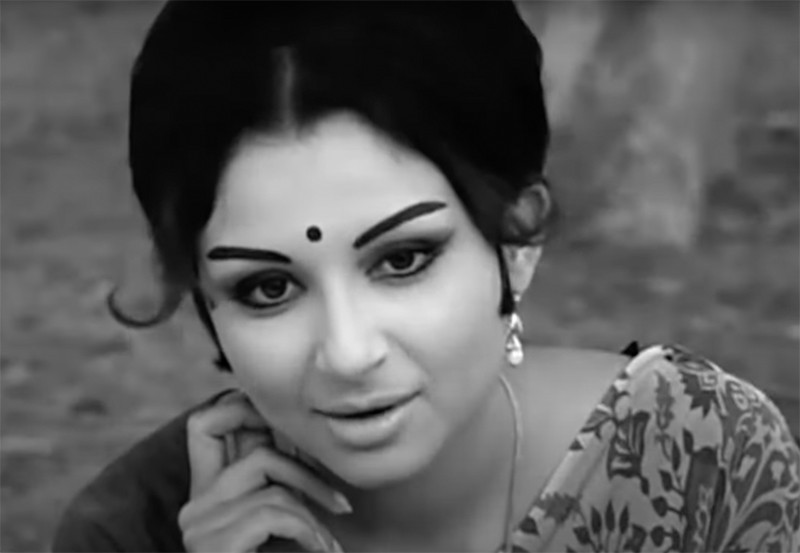 Sharmila Tagore plays the female lead
Sharmila Tagore plays the female lead
There is no true protagonist in this movie. All are deuteragonists (the actor taking the part of second importance in a classical Greek drama) playing roles of equal importance. They are all VVIPs as one of the characters is heard saying in the film. Sunil Ganguly’s novel deals with four unemployed youths during Bengal’s turbulent political scenario of 1960s who make an impromptu trip to the jungles to escape the dissonance of the city and seek refuge from the cacophony.
Ray has changed it to only one character namely Sekhar, unemployed. In lieu of this Ray paid attention to the title of the movie and blended the four disparate characters with the disposition and temperament of nature, here with the dense forests of Palamau in Bihar.
Nature plays a significant and far-reaching portrayal here, the four young men impersonating differently during daytime and at night, germane to the spirit and temper of the forest they had started enjoying unwittingly. At the end of the screening the movie does liberate its viewers because so much fun, frolic and wit has been assimilated by the master craftsman.
But the true essence starts working later in silence because the restless quiddity is eager to analyze each character as Ray had skilfully integrated every single viewer in these four men. Away from all the movies Ray had made, this one is different. He had kept its both ends open, solely delving and reliant on human consciousness with a persistent humor in his mind.
Crisscrossing the easy-going plot without notice, with abrupt, sharp cutting, lame, sombre situations Ray literally hits the viewer in an extemporaneous way. It is a contemporary film in all respects and perpetually lies ahead of its time, persistently urging each viewer to read in between the frames.
It is unworthy and inappropriate to commit everything in a film review as it blatantly and bluntly spoils a viewer’s ability to enjoy and appreciate a screening. But for those serious movie goers I must request them to notice carefully two different very similar roles Soumitra Chatterjee had portrayed, one in ‘The Coward’ as a protagonist suffering from indecision and in ‘Aranyer Din Ratri’ a deuteragonist afflicted with confusion. Indecisiveness focuses on the difficulty of choosing even when the options are clear, while confusion focuses on the difficulty of understanding.
It is the wit that flows silently often without notice maintains the movement and gesticulation of the film with some little but worthy, admirable hiccoughs. At least in one such singultus it freezes the viewer with a symbolic shot of impending sexual intercourse, that was never to happen, over a symphonic music that has gone astray with musicians playing wrong notes.
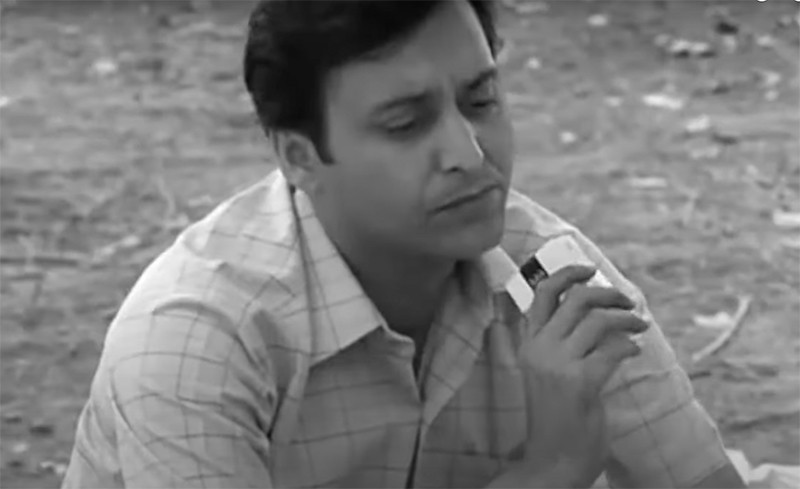 Soumitra Chatterjee plays Asim in the film
Soumitra Chatterjee plays Asim in the film
The characters in this movie are harmless but of value, representing literally every stratum from the Bengali community to where Ray too belongs. But a brief magic of seven minutes from Ray in the form of a memory game identifies every character in the cinema with elegance, grace and finesse. The actors spill names of prominent figures of their choice and provide a hint to their own disposition and persona.
But Aranyer Din Ratri is no carnival in full to be called a Carnivalesque. It is lively and it has a consistent voice. Dialogues are well organized and follow that of the modern urban setting as well as that of the Santhal community. Cuts, dissolves and symbolisms used by Ray follow a prose pattern. And, it does use a prosaic form avoiding poetic devices like meter and rhyme. If Charulata (The Lonely Wife) be called a poetry in celluloid, why not call Aranyer Din Ratri a prose of Dostoyevskian order.
(The writer is a Kolkata-based public health professional and a film enthusiast with keen interest in the works of Satyajit Ray. He can be reached at [email protected])
IBNS
Senior Staff Reporter at Northeast Herald, covering news from Tripura and Northeast India.
Related Articles

Bharti Singh and Haarsh Limbachiyaa welcome their second child
Comedian Bharti Singh and her husband, writer-host Haarsh Limbachiyaa, welcomed their second child on Friday.

IFFK backs down after Centre threat: three films pulled over ‘national security’ concerns
Thiruvananthapuram/IBNS: The organisers of the International Film Festival of Kerala (IFFK) 2025 have decided not to screen three films following strong objections and a threat of legal action from the central government, media reports said.

Security scare for Nidhhi Agerwal as fans swarm actress at The Raja Saab event in Hyderabad
Hyderabad/IBNS: Actress Nidhhi Agerwal faced a tense moment when her security was briefly compromised as she was mobbed by a large crowd while leaving the song launch event of her upcoming film The Raja Saab in Hyderabad.

George Clooney says goodbye to onscreen kisses at 64 — here’s why
In a notable shift in his acting career, Hollywood star George Clooney has revealed that he will no longer perform onscreen kisses, following discussions with his wife, human rights attorney Amal Clooney, media reports said.
Latest News

Canada to begin US trade talks in January, Canadian PM Carney says

Saudi Arabia’s Jeddah Tower to surpass Burj Khalifa, set to become world’s tallest building

Viral video of foreign tourists exploring New Delhi with a local auto rickshaw driver steals hearts!

Bharti Singh and Haarsh Limbachiyaa welcome their second child

